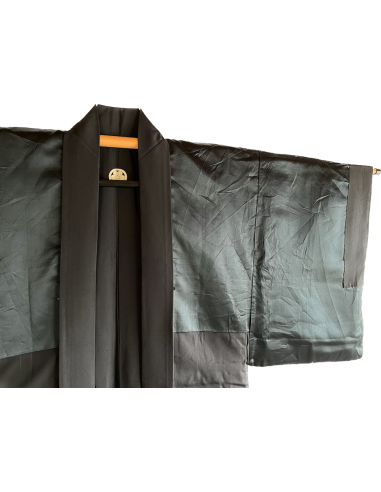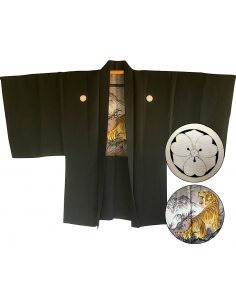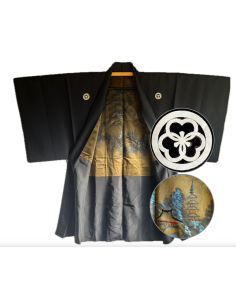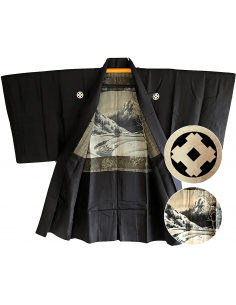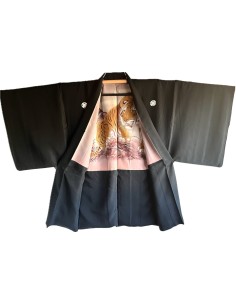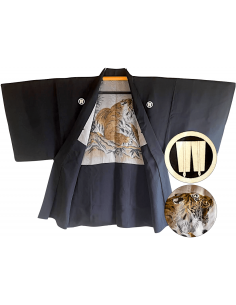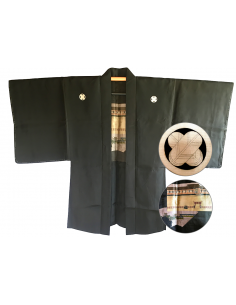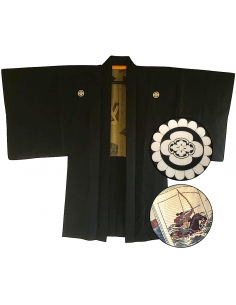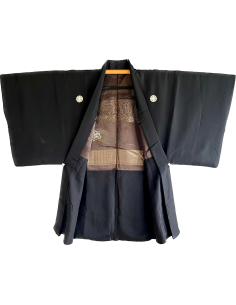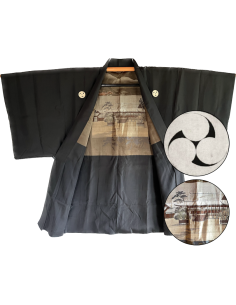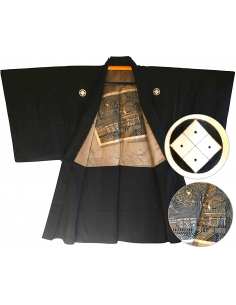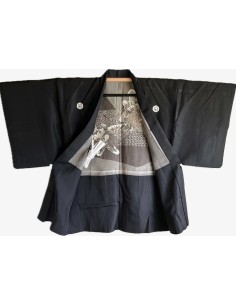Men's Vintage Haori Katabami Montsuki - Kyogen no Tanuki
100% black silk, the lining is bottle green in color. The embroidery motif on the lining depicts a scene from the Japanese Kyogen theater. This haori is adorned with 5 samurai family crests "Kamon Katabami
- Rare, unique and authentic piece
- True work of Japanese art
- Made in Japan
- Antique Haori kimono jacket
- Reserved for connoisseurs and prestigious clients
- 100% pure Habutae black silk
- Green bottle silk lining
- Adorned with 5 samurai family crests "Katabami"
- The embroidery motif on the lining depicts a scene from the Japanese Kyogen theater
Kamon Katabami:
The "Katabami" (片喰) is a kamon motif, a traditional Japanese heraldic emblem used to identify and represent families, clans or individuals. The Katabami, also called "One-sided Eaten" in English, is a particular motif representing a stylized clover or leaf, usually with a missing part.
Here are some key points about the Katabami kamon:
Meaning: The Katabami is often associated with positive meanings such as perseverance, growth despite challenges, and resilience. The presence of the missing part of the leaf symbolizes the ability to thrive even when obstacles are encountered.
Use: This motif has been used by several families and individuals in Japan as a family emblem. The use of kamon dates back several centuries, and these motifs were often present on kimonos, armors, banners, and other items to identify the person or family.
History: The exact origin of the Katabami is not always clear, but it has historical links with samurai and warrior clans. Some kamon, including the Katabami, have connections with legends and anecdotes from Japanese history.
Dimensions:
- Height: 100cm
- Shoulder Width: 61cm
- Sleeve Width: 33cm
- Sleeve Height: 51cm
- Sleeve to Sleeve Width: 128cm
Period: Showa (1989-1989)
Condition: Excellent (see photo details to make up your own mind)
Original gift to make for Christmas holidays!!
Kyogen (狂言) のTanuki 狸
Kyogen, a form of traditional Japanese comic theater, may also include scenes featuring the tanuki, an animal emblematic of Japanese folklore. The tanuki is often described as an animal resembling a raccoon dog or raccoon, but it is more broadly associated with a mischievous and magical creature in Japanese mythology.
Here is how Kyogen can integrate the tanuki:
- Tanuki Characterization: In Kyogen scenes with a tanuki, this animal is usually depicted in a comedic and mischievous way. The tanuki is often associated with transformation, and in the Kyogen context, this can lead to humorous situations.
- Prank and Deception: The tanuki is known for its ability to transform into various objects or even humans. Kyogen scenarios can exploit this characteristic to create comedic situations of deception, where the tanuki plays tricks on other characters.
- Human Interactions: Kyogen scenes with a tanuki can also explore interactions between the tanuki and human characters. Humorous conflicts, misunderstandings and mix-ups can result from these interactions.
- Symbolism: In the Japanese cultural context, the tanuki is often associated with good fortune and prosperity. Its inclusion in Kyogen scenes can bring elements of luck and positivity to the performance.
You might also like






